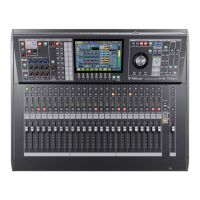118
Monitor/Solo
Monitor/Solo
fig.MonitorFlow.eps
Monitoring is a function by which the AUX, MTX, MAIN, or USB memory recorder signal that you select as the monitor source can be sent
from the output jacks or headphone jack. This is used mainly by a mixing engineer to monitor the signals.
The monitor output is split to the MONITOR OUT L/R and PHONES OUT, and the level of these two can be adjusted independently. You can
use the output patchbay to patch MONITOR OUT L/R to any desired output jacks.
Solo is a function by which the channel you select using a [SOLO] button is sent from the MONITOR OUT L/R or PHONES OUT jacks. This is
used to monitor a channel temporarily.
About monitoring
LR
SOLO
LR
SOLO
MONITOR OUT L
MONITOR OUT R
OUTPUT
MONITOR
SOLO
LEVEL
MONITOR
LEVEL
SOLO
LOGIC
MAIN LR OUT
MAIN C OUT
MAIN LCR
MAIN MONO OUT
REC OUT LR
MONITOR
MONITOR
SELECT
DELAY
DELAY
D/A
PHONES
LEVEL
PHONES
AUX 1–16 OUT
MTX 1–8 OUT
CASCADE OUT LEVEL
Normally, the monitor signal will be output to MONITOR OUT L/R and PHONES. Solo is enabled when you turn on Solo for a channel;
the signal of the channel for which Solo was turned on will be automatically sent to the Monitor output.
The top panel MONITOR section is used to perform Monitor/Solo
operations.
fig.MonitorSectGuide.eps z
LEVEL knob
This adjusts the monitor output level in a range of -Inf dB–
+10.0 dB.
DISP button
This accesses the MONITOR screen, where you can make
monitor and solo settings.
SOLO CLEAR button
This turns off the solo settings of all channels. It will blink if
any channels are currently being soloed.
1.
In the top panel MONITOR section, press [DISP].
fig.ScrMonitorGuide.eps
The MONITOR screen will appear.
Meters
These indicate the level of the AUX, MTX, MAIN, and
MONITOR.
Operations in the MONITOR section
1
2
3
1
Accessing the MONITOR screen
2
3
2
1
3
4
5
1
M-480_e.book 118 ページ 2011年3月2日 水曜日 午前9時20分

